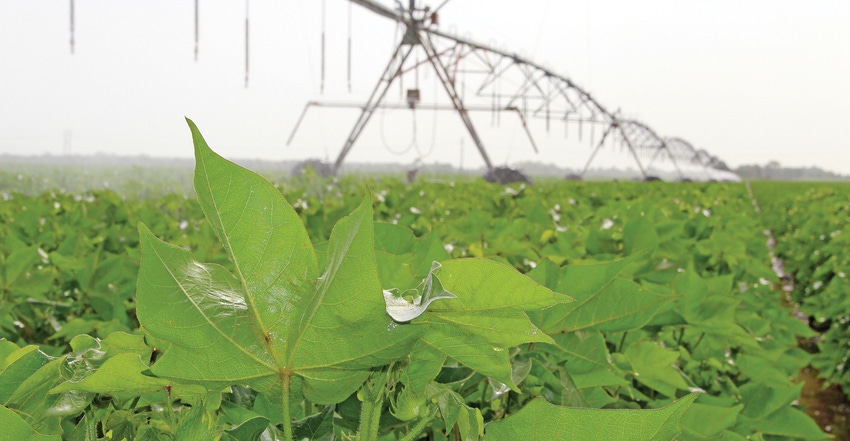November 1, 2021

Rainfall amounts have been trending upwards in the Lower Mississippi Valley, increasing 3.46 inches in April and 1.72 inches in May over the last two decades, according to NOAA’s National Centers for Environmental Information.
Not only has more rain been falling, but the frequency of the rains has resulted in more narrow planting windows and more planting delays for crops like cotton, which “doesn’t like wet feet.”
“This increase in total rainfall has also come with an increase in the frequency of heavy rainfall events,” says Eric Snodgrass, principal atmospheric scientist for Nutrien Ag Solutions. “Throughout most of the Mississippi Valley a doubling of the frequency of rainfall events that total more than 2 inches of rain in 24-hour time periods has been observed since 1980.
“Studies have found that in Iowa and Illinois, this increase has led to a four- to five-day loss in workable field days in April and May as defined by USDA. A similar trend is likely in the Lower Mississippi Valley.”
Complicating those rainfall statistics are the impacts of tropical cyclones which are capable of producing feet, not just inches, of rain throughout the growing season and harvest, said Snodgrass, who is based in Champaign, Ill.
If such weather patterns are becoming the new “normal,” what can producers do to help offset the potential yield loss?
For openers, growers should make sure a late crop doesn’t become even later, says Bill Robertson, Extension agronomist-cotton with the University of Arkansas System Division of Agriculture.
Early maturation
“That is, by doing everything they can to make the crop mature as early as possible, including adjusting seeding rates and fertility, managing plant growth and starting and ending irrigation in a timely manner. But the most important may be improving the structure of their soils.”
“Over the past few years, our planting window has seemed to shift later in the year,” said Tyson Raper, cotton and small grains specialist with the University of Tennessee. “While we have little control over what mother nature gives us, there are a few management strategies that can help us manage a cotton crop with a delayed start.”
Raper, Robertson and Brian Pieralisi, Extension cotton specialist with Mississippi State University, say an important first step is starting with a warm, uniform seedbed.
“Those in no-till acres will likely laugh at that, and rightly so – most of our acres cannot be hipped,” Raper says. “However, if you have bottoms which are not highly erodible, I would definitely suggest running beds when possible. Moving water away from a young seedling and allowing the seedbed to warm up quicker result in a much stronger start to the season. Again, this is only an option for a portion of our acres in Tennessee.”
“Obviously, you want to plant early or take advantage of any planting windows you get,” said Pieralisi. “The problem is we haven’t been getting those windows. If you have poorly drained fields, that can make planting even more difficult.”
Growers on the east side of Mississippi have been installing drain tiles “because they can’t landform or precision level their fields. We’re doing research on tiling and tile spacing at the North Farm here. They may not tile the whole field, but they’re putting it in places that keep them from planting.”
Those growers say they’re getting an extra day or two, Pieralisi says. “A day or two can mean a lot because farmers with precision planters can plant at a higher rate of speed, increasing their daily acres,” he said.
Tiling is an expensive option, Pieralisi notes. “It’s like precision land forming in the Delta, and even with precision land forming you run into a problem where only so much water can come off a field. It’s not going to come off any faster if you’re draining into a full body of water. They’re also experimenting with tiling in the Delta at the MSU Delta Research and Extension Center.”
Robertson said managing water often comes back to soil structure in the silt loam soils found in many Arkansas cotton fields.
Water infiltration
“If you look at the textbooks and when we measure in the fields it follows pretty close to that, water infiltration rates are about half an inch an hour,” he said. “That’s typically what we see when we don’t do a cover crop or we till. That’s why when we get two or two and a half inches of rain quickly most of it runs off.
“A lot of our farmers have track hoes they use to clean out their ditches to improve drainage. We plant cotton on beds to help get the water off because cotton does not like wet feet. But the silt that runs off the beds flows into the ditches, and the ditches silt up. The silt also carries off nutrients so that’s dollars running down the ditch.”
Farmers often try deep tillage to reduce soil compaction and improve infiltration or internal drainage, running a ripper to shatter the hard pan and loosen the soil. “Basically, we’re trying to make new channels or ditches,” said Robertson. “We clear the channels so we have passages for water to move down, but because we have poor soil structure the soil particles don’t stick together and those ditches silt up, too.
“Having increased soil microbe activity, organic matter and all that helps glue those soil particles together so they stay where they are. When we don’t have that glue holding our soil particles together — the mineral component which is sand, silt and clay — water moves silt down those channels we just opened up. The next thing you know those channels are plugged up and the water won’t move down.”
What other steps should farmers consider?
Properly select seeding rate. “Higher plant populations can push fruiting nodes higher on the plant and thereby delay maturity,” says Raper. “Earliness will be achieved by adjusting seeding rate based on seed quality and planting conditions. In most years, a target plant stand of 2.5-3 plants per foot will allow us to reach maximum yields.”
Growers have been moving toward more early to midseason varieties and away from full-season to avoid pushing harvest into October and November, Pieralisi noted.
Properly manage fertility. “In a later-established crop in which we are pushing earliness, this means backing off on nitrogen compared to your earlier planted acres,” Raper and Robertson said. “Excess nitrogen delays maturity and does not support earliness. Potassium and sulfur should not be neglected, but their application strategies will not likely differ from an earlier-planted crop.”
Maintain established insect thresholds and apply as soon as possible after meeting threshold, Pieralisi says. “This will help maintain first position fruit,” according to Raper. “In a later maturing crop, we often don’t have time to mature fruit higher on the plant or at more distal positions. Similarly, it is important to consider last effective bloom date and base all decisions on carrying as many fruiting positions as possible into that date (for Tennessee, often between Aug 12 and Aug 23). Flowers blooming after the last effective bloom date will likely not have enough heat units required to mature and make the picker basket.”
Aggressively manage plant growth. In a late-planted acre, sunlight needs to penetrate the canopy and reach the sympodial leaves low on the plant, Raper says. “Allowing excessive vegetative growth will shade lower positions and shift fruiting bodies to (again) higher or more distal positions.”
Don’t overwater. “When we have a late crop, irrigation timing is even more critical,” said Robertson. “When I first came to Arkansas, often we had a long switch at the top of the plant. For years we blamed the boll weevil for taking the late fruit on the stalk. But when we got into boll weevil eradication, sometimes we would still see fields with that switch.
“Tina Teague (Arkansas State University) had videos that indicated that with late initiation of irrigation — the plant stressing for water before first flower — we would have that tall switch at the top of the plant. It upset the balance of the cotton plant by starting watering too late.”
Growers are irrigating earlier now, but they don’t always stop watering soon enough. “In Arkansas, September irrigation water rarely pays for itself,” he said. “Sometimes mother nature takes care of that by giving us a big rain around Aug. 24 or 25th. But that’s the time we need to be backing out of watering cotton.”
The specialists say growers should identify the uppermost harvestable boll and trigger irrigation cutoff, defoliation and boll opening decisions based on that boll. “Keep in mind we need the plant to assist in the defoliation activity; if temperatures are too low, we will be much more likely to stick leaves than shake them,” said Raper.
“By targeting a realistic, achievable harvestable boll and watching the forecast, we should be able to use the last remaining heat units in the season to achieve a successful defoliation and boll opening application.”
About the Author(s)
You May Also Like






